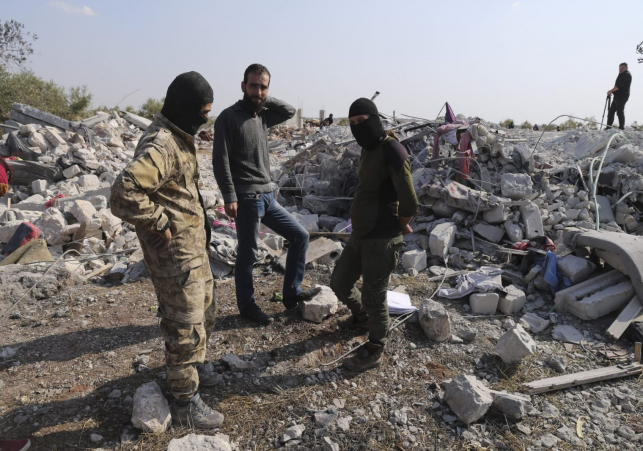

The Islamic State's leader, slain in a US strike in northwest Syria overnight, was mostly unknown, with almost no recognized images and no appearances in public or in the group's propaganda.
He was killed in the same rebel-held Idlib area where his predecessor, Abu Bakr al-Baghdadi, was chased down by the Americans more than two years ago, far from the main battlegrounds in eastern Syria and Iraq, where the group once claimed wide swaths of land in a self-proclaimed "caliphate."
He acquired the moniker Abu Ibrahim al-Hashimi al-Qurayshi after al-Baghdadi was killed in the October 2019 raid. He has been a veteran terrorist since the US-led invasion of Iraq in 2003.
It was up to him to manage the group's remnants as they reassembled after their caliphate fell apart and went underground to wage an insurgency in Iraq and Syria.
After years of low-level hit-and-run ambushes, IS militants had begun to carry out bolder, higher-profile strikes. Its members invaded a prison in northeast Syria last month to liberate their imprisoned compatriots, sparking a 10-day battle with Kurdish-led forces that left 500 people dead.
It's uncertain whether his death will halt the group's momentum now.
Amir Mohammed Saeed Abdul-Rahman al-real Mawla's name was Amir Mohammed Saeed Abdul-Rahman al-Mawla, an Iraqi in his mid-40s who was born in 1976 and is thought to be an ethnic Turkman from Tel Afar in northern Iraq. He graduated from Mosul University with a degree in Islamic law.
When he became IS' "caliph," he adopted the epithet al-Qurayshi, implying that he, like his predecessor, claimed ties to the tribe of Islam's Prophet Muhammad.
Al-Qurayshi spent his final days in Idlib province, which is occupied by insurgent forces hostile to IS, like his predecessor, who was assassinated barely 24 kilometers (15 miles) away in the village of Barisha.
In the town of Atmeh, close to the Turkish border, he was staying in a two-story house. According to first responders, he and 12 others were killed in the early Thursday raid on the house, which included four women and six children.
Few in Atmeh knew who the family that rented the house was after the raid. Journalists on the scene were told by neighbors that the man who resided on the second story with his family had previously identified himself as Abu Ahmad, a Syrian who had fled Aleppo province because of the fighting.
The final major opposition bastion in Syria, Idlib province, has a population of 3 million people, many of whom have been uprooted by the civil war, making it simple for foreigners to fit in. Al-Qurayshi appears to have chosen the property, which is surrounded by olive trees, to be as far away from spectators as possible.
Around midnight on Wednesday, US special forces helicopters landed in the neighborhood and closed in on the residence.
“If you don't leave, we have orders. We will fire missiles toward the house. There are drones overhead.”
Through a loudspeaker, a man speaking in an Iraqi accent could be heard saying. On social media, an audio clip was shared.
Later, an explosion rocked the region, knocking out much of the top floor.
The opposition's Syrian Civil Defense, better known as the White Helmets, published videos showing a paramedic transporting a young child from her home onto an ambulance. Later, a photo of a girl with blood on her face surfaced on social media, depicting a girl who appeared to be around five years old.
“They killed my mother and father,” The youngster was quoted as telling paramedics who rescued her, "They slaughtered my mother and father." It was unclear whether the young lady was al-daughter. Qurayshi's
According to Al-Arabiya TV, three of the four ladies killed in the raid may have been the extreme leader's wives. Members of extremist groups are frequently married to up to four women, as permitted by Muslim practice.
Al-Qurayshi has led the wanted list of the US and other regional nations combating the jihadists since gaining ahead of IS.
The State Department designated al-Qurayshi as a Specially Designated Global Terrorist on March 18, 2020. A few months later, the US increased the reward for information leading to his identity or whereabouts to $10 million. Abu Omar al-Turkmani and Abdullah Qaradash were two more noms de Guerre for al-Qurayshi.
Al-Qurayshi began his violent action shortly after Saddam Hussein, Iraq's former ruler, was deposed. Al-Qurayshi joined al-Qaida in Iraq, which is led by Jordanian jihadist Abu Musab al-Zarqawi, a year after the US-led invasion of Iraq in 2003.
In 2004, US troops detained Al-Qurayshi in Mosul, where he was incarcerated for two years. During his detention, he rose through the ranks of al-security Baghdadi's henchmen.
Al-Qurayshi became a prominent figure with the al-Qaida affiliate's successor group, the Islamic State in Iraq, which under al-Baghdadi morphed into the Islamic State group after al-Zarqawi was killed in a US strike.
Also read: